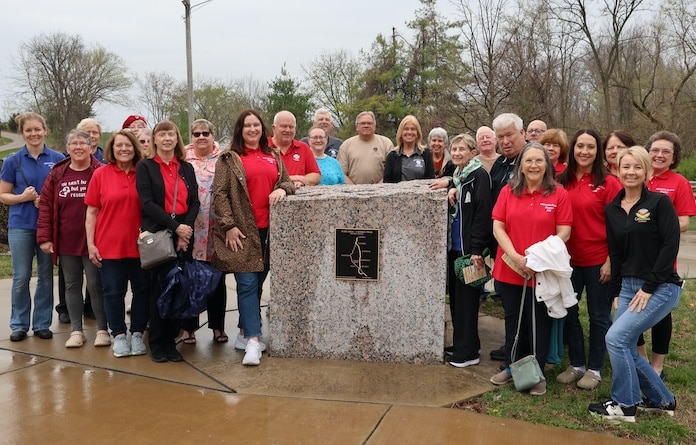Marking the Kaskaskia-Cahokia Trail

Members of the Whiteside Station Chapter of the Daughters of the American Revolution and others in the community gathered Saturday morning for a dedication of a new marker along the historic Kaskaskia-Cahokia Trail.
Though slightly damp amid the light rain that preceded heavy storms later in the day, the crowd gathered at the historic Shoemaker School building at the intersection of Gall Road and Route 3 in Columbia.
Sarah Karban of the Whiteside Station Chapter spoke of the trail’s history.
She explained the marker designates both the upland and bottomland trails, with the upland trail becoming the most widely used route from Prairie du Rocher to Cahokia – more reliable as it wasn’t prone to flooding like the bottomland trail.
Karban noted these trails are largely represented by Route 3 and Bluff Road today.
The trail first served as a trade route for American Indians in the area long before it was introduced to French colonists who came to the area in the late 1600s.
The French established the settlements of Kaskaskia and Cahokia – named after local Illinois Indian tribes – and though the trail currently bares the names of these settlements, it was known for some time as the King’s Road in honor of King Louis XV.
Karban further spoke to the trail’s history and the growth the area around it saw through the years, with forts and settlements forming and roads from them connecting to the trail. The heavy growth was among the reasons why Kaskaskia served as the first state capitol when Illinois joined the union in 1818.
Local historian Dennis Patton of Columbia offered additional historic information to the Republic-Times following this dedication.
He noted the stone arch bridge near the new trail marker is one of many such bridges that could be found around Monroe County in the past.
This bridge crossed over Wilson Creek and it features a peculiarity with an incised keystone inscribed with “B.S. 1898.” It’s believed the bridge was built in 1898 by Bernhardt “Ben” Sievers, aided by Charles Trautman on land donated by Harry Reichert’s Grandpa Whiteside.
The bridge was built over a semi-circular wooden framework called the centering, with stone stacked over the arch from the bottom up, with a keystone placed at the top. The wooden form was then knocked out, and the stones stood on their own.
Patton additionally spoke about Shoemaker School, a log school building constructed in 1851 by Hammond Schoemaker on his farm south of Columbia for his children and nearby families.
A new brick school building was built on the farm in 1867 by Fred Koch Construction for $800, the school originally standing on the west side of Route 3 across from Gilmore Road.
Closing out her speech, Karban expressed thanks for those who joined the dedication ceremony, including members of the Kaskaskia-Cahokia Trail Coalition, Monroe County Genealogical Society, Down State Illinois Tourism, Monroe County History Museum, and Lewis & Clark Chapter of the Sons of the American Revolution along with city officials.






